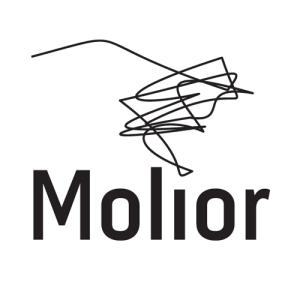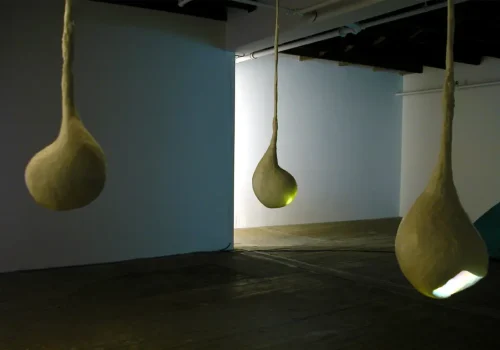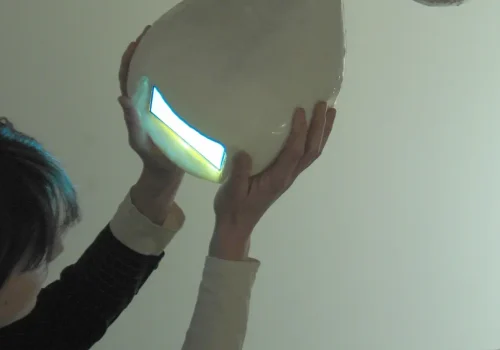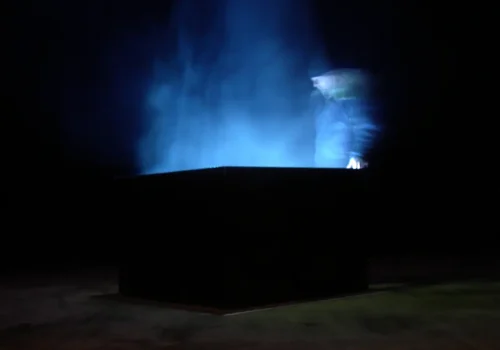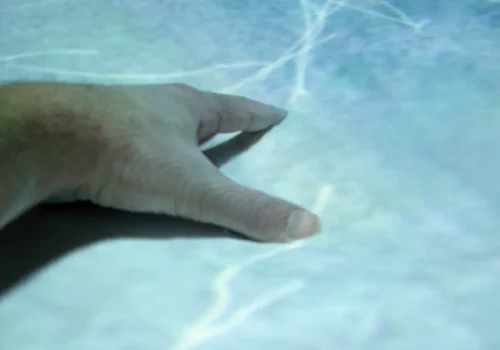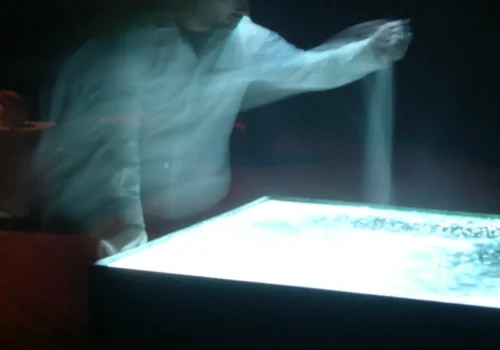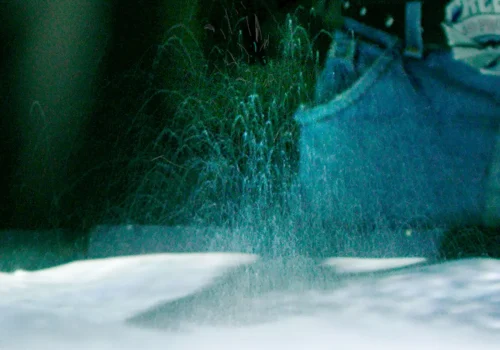Magnitudes et Saisissement
Maison de la culture Frontenac, Montréal
From January 31st to March 5th, 2006
Groupe Molior presents two interactive installations from January 31 to March 5, 2006 at the Maison de la culture Frontenac.
The two projects, Magnitudes by François Quévillon and Saisissement by Clara Bonnes, are unusual in emphasizing touch within the artistic experience. Magnitudes is a multisensory installation that enables the visitor to transform matter, in both the real world and the virtual, while evoking natural phenomena characterized by instability. The project invites us to consider natural forces not as something to be conquered, but as something we can interact with playfully. Saisissement invites visitors to hold and manipulate objects outfitted with touch sensors to animate the images they present. The videos created in this interaction provide opportunities for journeys and meetings that bring into question the relationship between intimate and public spaces.
Andrée Duchaine
Andrée Duchaine has worked in the visual arts area since several years. From 1974 to 1984 she was involved in setting up the video section at Vehicule Art Gallery and organized and curated VIDEO 84, the first international video encounters in Montreal. Mrs Duchaine curated several video art exhibitions in Europe, the United States and Canada. Between 1985 and 1995 she settled in Paris where she founded a short film distribution company. She worked with T.V. channels across the world.
Andrée Duchaine taught at Paris VIII, at the Université du Québec à Montréal and at the Ottawa University. In 2001 she founded a non-profit company Le Groupe Molior producing, curating and disseminating new media works.
Sylvie Parent
Sylvie Parent is an independent curator and art critic. She has been involved in the visual and digital arts scene for more than 30 years, both in Quebec and abroad. Her exhibitions have been shown in Canada, the United States, Italy, Brazil, China and Taiwan. From 2009 to 2014, she was artistic director of Molior, an organization specialized in the production of exhibitions on the international scene. In the field of publishing, Sylvie Parent acted as editor of magazines such as HorizonZero (2003-2005) and CIAC Electronic Magazine (1997-2000), and contributed to several specialized journals (Parachute, Ciel variable, Espace art actuel, etc.). She is also the author of numerous essays for exhibition catalogues. Sylvie Parent is a recipient of the Joan-Lowndes Award (2017) given by the Canada Council for the Arts to an independent art critic or curator in recognition of the outstanding quality of her work.
Artists & works
Clara Bonnes
Saisissement
2006
Interactive video installation
Description of the work
Saisissement is a real-time interactive video installation that includes three silicon modules suspended from the ceiling. Each module uses a six-inch LCD screen and various flexion sensors, all contained in ovoid shaped flexible expanding foam covered with silicon. The texture of the objects is similar to that of a breast implant. The objects are connected to computers by modified game controllers, which control Max/MSP/Jitter patches. The programming differs subtly from one object to the next, making for three distinct portraits: each object thus has a different personality in relation to the subject represented, different reactions to the audience’s manipulation. The video and photo content presented was shot in three distinct homes, and features three different subjects represented in their domestic spaces.
The audience is invited to enter the private space of the three subjects, and intimately experience each video object to discover its subtle reactions. Each module functions on the same programming base, allowing it to slow down or speed up the rhythm at which the image is read. However, each one reacts differently when the spectator presses it more intensely. The Alexandra module (presented on the video documentation) interchangeably displays stills and close-ups in transparency. This portrait aims meld the subject into his immediate environment, so one can no longer be dissociated from the other, as though they issue from the same sensory experience. The Hermès module allows stills of intimate scenes to appear in rapid succession. This portrait aims to bring out the subject’s intense and spontaneous character, coloured with a touch of exhibitionism. Lastly, the Pascale module allows the sequence to be changed in mid-reading. This last portrait brings out the multiple aspects of the subject and his environment; one after another, living space, work space and exhibition space, the unit of this sequenced space is portrayed using manipulated jumps in time. Cuts from one shot to another are synchronized with movement in the space. These different temporalities jump back and forth.
Biography
After earning her Bachelor’s in the aesthetics and science of art at the Sorbonne in Paris, Clara Bonnes completed her Master’s in visual arts and media at UQAM. Her research dealt with the ways in which various portraits can be revealed through the perception of space, both public and intimate. Her video installations have been exhibited at the Musée Régional de Rimouski, the Art Mûr gallery in Montréal, L’Écart, a centre for contemporary art in Rouyn Noranda, Agora / Festif, the VAV-Concordia gallery and CDEx-UQÀM in Montréal, the Centre régional d’art contemporain de Soisson in France, and the Michel Journiac gallery in Paris. She is interested in the gaps it is possible to create in public spaces. This interest led her to arrange various nocturnal video projections in urban spaces during the Itinéraire Bis and Nuits Blanches events at CDEX in Montréal, among others. Active member of Vidéographe and the board of directors of Dare-Dare, she has also participated in the organisation of the video projection events EICV 2004 and EICV 2005 as well as Itinéraire Bis 2005.
François Quévillon
Magnitudes
2006
Interactive video installation
Description of the work
This interactive installation by François Quévillon forms part of his artistic mandate of exploring the evocative force of natural phenomena. The spectators are immersed in an ambiophonic sonic environment and brought into contact with an unstable surface where energy is transferred between the public and the work.
Magnitudes makes use of two video recognition interfaces that feed an interactive process allowing an individual or collective experience. Polysensoriality is widely explored within the work: in addition to the participant’s vision and hearing, tactility plays an important role due to an interactive “matter-screen”. The closeness of the device elicits the participant’s touch by focusing on the positions and movements of the participant’s hands for an experience that integrates haptic perception and physical feedback that affects the body as a whole. The sound dimension is omnipresent: to the ambiophonic environment that introduces the spectator to the work are added two sound compositions that result from the interaction. The installation explores the relationship between virtual and physical spaces by enabling the spectator to alter them.
Magnitudes takes the shape of a 2’9” tall sculptural object with a surface area of 4′ by 4’. The device’s flexible surface, which serves as a platform and an interactive screen, is covered with white grains of variable dimensions, giving a materiality to both the projected images and the interactive sound track. The participants’ movements on this glacier-like surface are traced by ephemeral uneven lines, similar to fissures, and accompanied by cracking noises. The “matter-screen” vibrates depending on the activity detected in the immediate perimeter of the work and its surface, and this vibration is due to a droning sound, which becomes increasingly evident during the interaction and diminishes in periods of inactivity. A collective experience of the work brings together the actions of the participants depending on their degree of involvement by tracing lines between them.
François Quévillon would like to thank Freeset Interactive, the Interstices research/creation group and Groupe Molior for their involvement and support.
Biography
In his media installation practice, François Quévillon creates interactive works and immersive environments in which polysensorality plays a starring role. He explores the phenomena of chain reactions as well as the instability of states of matter. His achievements confer aesthetic and poetic experience on the spectator, invoking several aspects of the subject’s body awareness through mechanisms that suggest various types of action and perception.
François Quévillon is currently studying at the Master’s Program in Visual and Media Arts at the École des arts visuels et médiatiques, UQAM. Recipient of a bursary from the Fonds québécois de recherche sur la société et la culture (FQRSC), he also received a Royal Canadian Academy of Arts Scholarship in 2005 and the Jury prize in the Nouvelles Images (New images) category for the 2002 edition of Vidéaste recherchée. His work has been shown in Canada, Brazil and over the Internet. He has been a member of the Interstices research and creation group since 2001.
